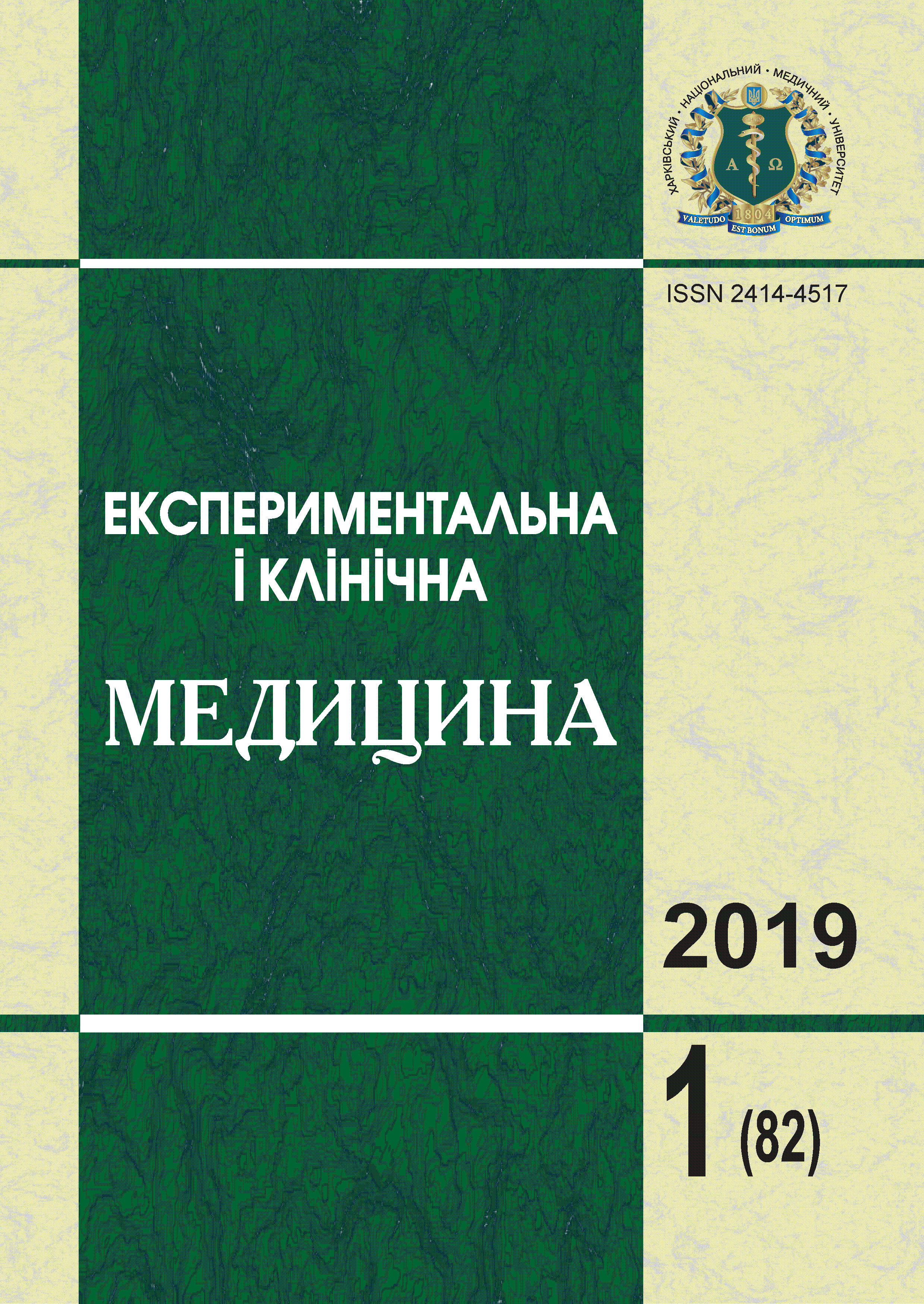Анотація
Проведено фармакогенетичне дослідження 83 дітей з фармакорезистентними епілепсіями віком від 11 місяців до 18 років. За допомогою алель-специфічної полімеразної ланцюгової реакції (ПЛР), визначали поліморфізми гена CYP2C19 (CYP2C19*1, CYP2C19*2). Алель CYP2C19*2 нами зафіксований у 33 (39,76 %) пацієнтів. У 5-х (15,15 %) з них носійство генотипу CYP2C19*2 виявлено в комбінації з іншими поліморфізмами генів (СYP2C9*2, CYP2C9*3, CYP3A4*1B). Поліморфізм CYP2C19*2 в обстежуваних нами пацієнтів зустрічався достовірно частіше ніж в українських та інших європейських популяціях.Посилання
Alexopoulos Andreas V. (2013). Pharmacoresistant epilepsy: Definition and explanation. Epileptology, vol. 1 (1), pp. 38–42.
Kwan P. (2011). Drug resistant epilepsy. N Engl J Med, vol. 365 (10), pp. 919–926.
Perucca E. (1998). Pharmacoresistance in epilepsy: how should it be defined?, CNS Drugs, vol. 10 (3), pp. 171–179.
Guerrini R. (2006). Epilepsy in children. The Lancet, vol. 367 (9509), pp. 499–524.
Panayiotopoulos C.P. (2005). The epilepsies: seizures, syndromes and management. Chipping Norton: Bladon Medical Publishing, 541 p.
Kwan P. (2000). Early identification of refractory epilepsy. N Engl J Med, vol. 342 (5), pp. 314–319.
Hauser E. (1996). Prognosis of childhood epilepsy in newly referred patients. J Child Neurol, vol. 11, pp. 201–204.
Franciotta D. (2009). Genetic basis for idiosyncratic reactions to antiepileptic drugs. Curr. Opin. Neurol, vol. 22 (2), pp. 144–149.
Kukes V.G. (2017). Klinicheskaya farmakogenetika [Clinical pharmacology] pod red. V.G. Kukesa, D.A. Sycheva. – M.: GEOTAR-Media, 1024 p. [in Russian].
Ingelman-Sundberg M. (2004). Human drug metabolising cytochrome P450 enzymes: Properties and polymorphisms. Naunyn Schmiedebergs Arch Pharmacol, vol. 369 (1), pp. 89–104.
Miners J.O. (1998). Cytochrome P4502C9: an enzyme of major importance in human drug metabolism. Br J Clin Pharmacol, vol. 45 (6), pp. 525–538.
Lewis D.F. (2004). 57 varieties: the human cytochromes P450. Pharmacogenomics, vol. 5 (3), pp. 305–318.
Steinlein O.K. (2010). Gene polymorphisms and their role in epilepsy treatment and prognosis. Naunyn-Schmied Arch Pharmacol, vol. 382 (2), pp. 109–118.
Scordo M.G. (2004). Allele and genotype frequencies of CYP2C9, CYP2C19 and CYP2D6 in an Italian population. Pharmacol Res, vol. 50 (2), pp. 195–200.
Arvanitidis K. (2007). Genetic polymorphisms of drug-metabolizing enzymes CYP2D6, CYP2C9, CYP2C19 and CYP3A5 in the Greek population. Fundam Clin Pharmacol, vol. 21, pp. 419–426.
Herman Darja. (2003). Genetic polymorphism of cytochromes p450 2c9 and 2c19 in Slovenian. Population zdrav vestn, vol. 72, pp. 347–351.
Aynacioglu A.S. (1999). Low frequency of defective alleles of cytochrome P450 enzymes 2C19 and 2D6 in the Turkish population. Clin Pharmacol Ther, vol. 66, pp. 185–192.
Kapedanovska Nestorovska A. (2015). Distribution of the most Common Genetic Variants Associated with a Variable Drug Response in the Population of the Republic of Macedonia Balkan. J Med Genet, vol. 17 (2), pp. 5–14.
Chang M. (1995). Use of omeprazole as a probe drug for CYP2C19 phenotype in Swedish Caucasians: Comparison with S-mephenytoin hydroxylation phenotype and CYP2C19 genotype. Pharmacogenetics, vol. 5, pp. 358–363.
Gaikovitch E. (2003). Polymorphism of drug-metabolizing enzymes CYP2C9, CYP2C19, CYP2D6, CYP1A1, NAT2 and of P-glycoprotein in a Russian population. Eur. J. Clin. Pharmacol, vol. 59 (4), pp. 303–312.
Zand N. (2007). Genetic polymorphisms of cytochrome P450 enzymes 2C9 and 2C19 in a healthy Iranian population. Clin Exp Pharmacol Physiol, vol. 34 (1-2), pp. 102–105.
Saeed L.H. (2013). Genotype-Phenotype analysis of CYP2C19 in healthy Saudi individuals and its potential clinical implication in drug therapy. Int J Med Sci, vol. 10, pp. 1497–1502.
Roh H.K. (1996). CYP2C19 genotype and phenotype determined by omeprazole in a Korean population. Pharmacogenetics, vol. 6, pp. 547–551.
Zhong Z. (2017). Analysis of CYP2C19 Genetic Polymorphism in a Large Ethnic Hakka Population in Southern China. Med Sci Monit, vol. 23, pp. 6186–6192.
Kubota T. (1996). Genotyping of S-mephenytoin 4′-hydroxylation in an extended Japanese population. Clin Pharmacol Ther, vol. 60, pp. 661–666.
Lee S.S. (2007). Comparisons of CYP2C19 genetic polymorphisms between Korean and Vietnamese populations. Ther. Drug Monit, vol. 29, pp. 455–459.
Sukasem C. (2013). CYP2C19 polymorphisms in the Thai population and the clinical response to clopidogrel in patients with atherothrombotic-risk factors. Pharmgenomics Pers Med, vol. 6, pp. 85–91.
Yang Y.S. (2004). Genetic polymorphism of cytochrome P450 2C19 in healthy Malaysian subjects. Br J Clin Pharmacol, vol. 58 (3), pp. 332–335.
Luo H.R. (2006). Genetic polymorphism of cytochrome P450 2C19 in Mexican Americans: a cross-ethnic comparative study. Clin. Pharmacol. Ther, vol. 80, pp. 33–40.
Bravo-Villalta H.V. (2005). Genetic polymorphism of CYP2C9 and CYP2C19 in a Bolivian population: an investigative and comparative study. Eur J Clin Pharmacol, vol. 61, pp. 179–184.
Kresyun V.Y., Antonenko P.B. (2011). Polimorfizm henu tsytokhromu-450 2S19 na pivdennomu zakhodi Ukrayiny [Polymorphism of the cytochrome gene P450 2C19 in southwest Ukraine]. Zaporozhskyy medytsynskyy zhurnal – Zaporozhye Medical Journal . vol. 13, № 6, pp. 36–38. [in Ukrainian].
Levkovych N.M., Gorovenko N.G. (2014). Kharakterystyka henetychnoyi struktury naselennya Ukrayiny za polimorfnymy variantamy heniv systemy detoksykatsiyi ksenobiotykiv [Characteristics of the genetic structure of the population of Ukraine for polymorphic variants of the genes of the xenobiotic detoxification system]. Faktory eksperymentalnoyi evolyutsiyi orhanizmiv – Factors of experimental evolution of organisms, vol. 14, pp. 208–211 [in Ukrainian].
Seven Mehmet. (2014). The Effect of Genetic Polymorphisms of Cytochrome P450 CYP2C9, CYP2C19 and CYP2D6 on Drug-Resistant Epilepsy in Turkish Children. Molecular Diagnosis & Therapy, vol. 18 (2), pp. 229–236.
Guzeva O.V., Imyanitov Ye. N. (2013). Klinicheskoye znacheniye issledovaniya polimorfizma genov detoksikatsii sistemy P450 CYP2C9 i CYP2C19 u detey s epilepsiyey [Clinical significance of studying genetic polymorphism of the P450 CYP2C9 and CYP2C19 detoxifying enzyme genes in epileptic children]. Epilepsiya i paroksizmal'nyye sostoyaniya – Epilepsia and paroxyzmal conditions, vol. 5 (3). pp. 17–23 [in Russian].
Garcia M., Feria-Romero I. A., Fernando-Serrano H., Escalante-Santiago D. (2014). Genetic polymorphisms associated with antiepileptic metabolism. Frontiers in bioscience, vol. 6 (2), pp. 377–386.

